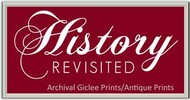 Loading... Please wait...
Loading... Please wait...All prices are in All prices are in AUD
Categories
- Home
- Blog History Revisited
- Carl Stratmann
Blog History Revisited - Carl Stratmann
South Australia Confectionary, Colonial German Migrants & World War I
Posted by ©Sandra Ker, Antiquarian Print Gallery 1989-2021, South Australia. Antique Print Dealer. www.historyrevisited.com.au on 9th Jan 2018
Why did whole German villages migrate to a British prototype colony?
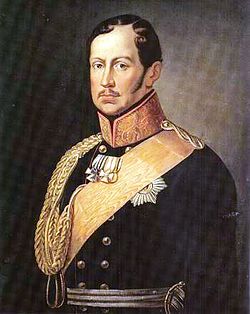 For all of Adelaide's aspiring to be "A slice of London in the Antipodes", the colony attracted a large Lutheran population by virtue of Adelaide's religious liberty and status as a Paradise of Dissent.
For all of Adelaide's aspiring to be "A slice of London in the Antipodes", the colony attracted a large Lutheran population by virtue of Adelaide's religious liberty and status as a Paradise of Dissent.
This new British settlement coincided with Frederick William III's determination to united the Protestant churches of Prussia in the 1830s & 1840s. The Old Lutherans refused to this change in church edicts so searched for new homes abroad.
George Fife Angas, the London financier had founded the South Australia Company to promote and invest in this brave prototype colonial model. As a Baptist he believed in worship free of intermediaries ie Bishops and Popes. Fife was keen to render assistance to their plea, in the service of Religious freedom. On the philanthropic-moral hand their was the right to religious freedom, but on the other their was the investment returns for he and his partners.
The legacy of that history were the Village of Klemsic (now the inner suburb of Klemzig) on the River Torrens, Bethany, Lobethal & Lyndoch in the Barossa Ranges with many more to follow.
Adelaide CBD, South Australia Circa 1880s
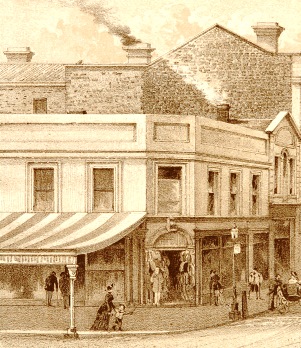 Corner King William St and Rundle St. by Louis Henn & Co. 1882-84
Corner King William St and Rundle St. by Louis Henn & Co. 1882-84
In the meantime publisher Louis Henn & Co set up a Lithographic printing studio in Currie Street, Adelaide. Henn had arrived in 1878 & set about recording the progress of Colonel William Light's planned city nearly 50 years after Governor Hindmarsh's Proclamation at Holdfast Shores in 1836.
The prominent corner of Rundle Mall & King William Road had been a desirable retail site from the get-go. In 1849 a Messrs. Brewer & Robertson ‘beg most respectfully to inform the inhabitants of Adelaide’ that they had opened their store, with linens and drapery from ‘all the principal manufacturing towns in the United Kingdom’. Their new store was called The Bee Hive. Henn's lithographers capture the same store 33 years later, still trading and thriving.
Enter the 1913 arrival of Carl Stratmann was born in Kerberg, Germany. He was a trained confectioner who had worked in Berlin, Copenhagen and London before migrating his talent to Melbourne in 1891 were he worked for MacRobertson's. Later, Stratmann set up a confectionery business in Sydney in 1905, arriving in Adelaide in September 1913. He set up business in a long thin shop, next door to the The Bee Hive Drapers, at 34 King William Street.
Carl “was artistic with his confectionery business and is an artist who is fairly unknown but had worked in Europe before coming to Australia.” Upon speaking to grand-daughter, she mentions that “he was an individual character”. I interpret that as a man of steely determination...
Riddle of the Carl Stratmann Etching
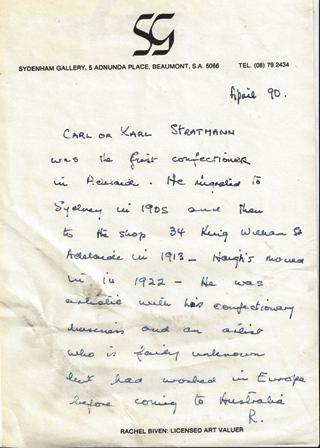
In 2003 the wonderful Elizabeth Tolley, married to Reg Tolley of Tolley Wines fame, came into the gallery with an etching showing all the hallmarks of neglect. It had been purchased in an Adelaide Hills secondhand shop in its original acidic frame presentation. That is not all bad news as that originality gave further histoical insight, but it was in desperate need of TLC. "You'll like this challenge Sandy!", she says joyfully. After the yellowing of the aggressive Lignin acid (a legacy of its wood-pulp presentation) had been removed, it revealed a very fine dry point etching, signed by a Carl Stratmann. It was in thinest-of-thin half round black frames, a typical choice for an early twentieth century etching. Circa 1900 frame-shops did not have the advantage of the global supply chain of the 21st Century.
Taped onto the acid affected brittle dust cover on the rear was a brief hand written assessment of Stratmann by Rachel Biven dated 1990. I knew that name. She had owned Sydenham Gallery in Norwood circa 1970. I was thrilled to see this note dated 1990, 20 years later. Rachel had written an excellent book, Some Remembered, Some Forgotten, a record of female colonial artists published in 1972.
Entitled “Old Settler’s Home at Kersbrook” Rachel Biven writes, “Carl Stratmann was the first confectioner in Adelaide”, but had closed the business in 1915. I was discombobulated! Was not Alfred E. Haigh, the German settler who established the legendary "Haigh's Chocolates", the bearer of that honor? This historical thread needed a tug! (Subsequent 2016 research by Barbara Santich is most worth following)
Rachel notes, "(Stratmann) was artistic with his confectionery business and an artist who is fairly unknown but had worked in Europe before coming to Australia". So he was experienced in etching, proven by the quality of what emerged from the cleansing bath after restoration. I placed the restored etching online in May 2015. Within the week Stratmann's Sydney grand-daughter made contact. I am only know realizing the significance of the date just over a century to the day, that Stratmann's business suffered due to the failed Gallipoli campaign. She was thrilled to see an example of Carl's artistry while he lived in Adelaide. Her family were not aware of any etchings he did during his time in South Australia.
Torren's Island German Internment Camp Protest
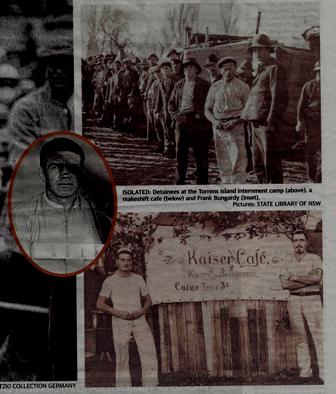
Torrens Island Interment Camp/Kaiser Cafe…German-Aussie humour?
It seems that the money "Alf" Haigh paid for the business in 1915, for not only the leasehold, he also bought Carl's recipes, library,equipment & the rights to use his trade motto, "Confiserie Surfine”. Stratmann placed this payment in a Swiss bank account. Why? With Anti-German feeling so high during The Great War (1914-1918), Adelaide followed the national trend in boycotting German place names - eg Hahndorf became Ambleside, Blumberg became Birdswood, popular traditional German food was renamed-"Fritz" became "Australian sausage". Many German men, the main source of family income, were taken to the Torren's Island Camp.Torrens Island, in the Port River estuary, became an internment camp where they were treated like prisoners of war. It was a mosquito infested ex-quarantine location. What did Stratmann do to protest this action? He hung a German Flag in his central CBD window. However, it was coincidentally 1915, the year of Gallipoli, the first time sovereign Australian soldiers were to die in battle. The traumatic statistics of ANZAC deaths made his moral protest pointless. The internment, and eventual brutal mistreatment, of ex-pat Germans, was a sad, yet predictable backlash by the locals in support of our troops. Of all Australian intern camps, it seems Torrens Island earned the reputation of being the worst. When the Kaiser Willhelm's Government heard of this, they let the South Australian politicians know that if it did not close the camp, South Australian troops would receive the same brutal treatment.
Stratmann feared the Haigh payment may be confiscated by the Government in retaliation of his humane protest. He did not draw on this money, such was his future success, even during the 1930 Great Depression. However, it seems a paranoia born of that era caused him not to mention the existence of the Swiss account for fear of retrospective punishment. It was not until 70 years later in the 1980s that an investigation into WWII German forgotten Swiss bank accounts gave his descendants the good news of their Patriarchs posthumous windfall.
The Legacy of Friends
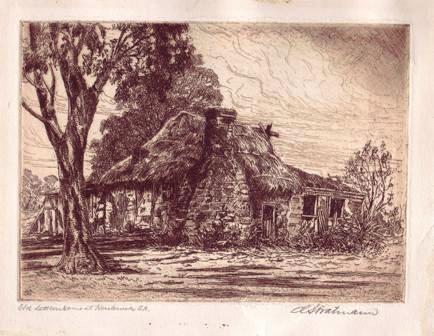 “Old settler’s Home at Kersbrook, SA” Original etching by Carl Stratmann, brought in for restoration.
“Old settler’s Home at Kersbrook, SA” Original etching by Carl Stratmann, brought in for restoration.
The successful paper restoration uncovered the local framer’s label of Dimond & Son, who had written the customer's details on the rear of the paper, a quaint habit of past framers. This discovery has given us a peephole through a crack in time circa 1915, itself a record of a earlier Colonial Scene. I was even more besotted with it. Nevertheless, the idea of it being owned by his descendants who fondly remembered him, seemed only right and just.
Influence of Gallipoli
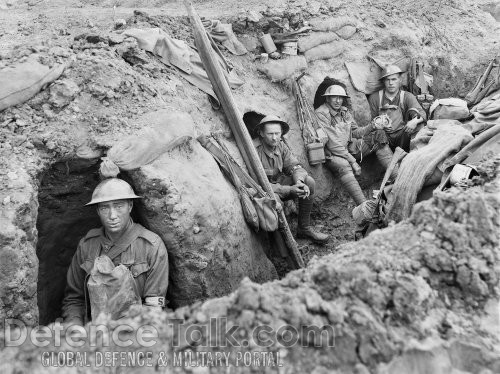
Gallipoli commenced on 25 April 1915 This was the first major battle where Australia and New Zealand forged a national conscience with massive loss of life. Stratmann may have been reasonably protesting against inhumane behaviour, but “soon tired of the taunts and harassment and sold his business ”.
Alfred Ernest Haigh’s Chocolate Empire
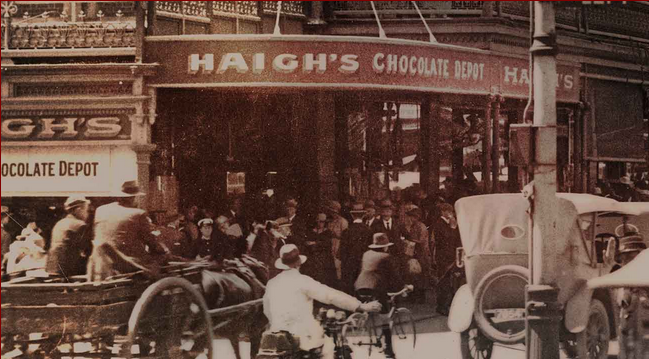
Beehive Corner, corner King William St and Rundle Mall – State Library of SA
What was one German immigrant's protest was another's opportunity in the "Big Smoke".
Alfred Ernest Haigh,(1877-1933) had ventured up from Mount Gambier to test the capital city market for his selection of confectionery.
He purchased Carl Stratmann’s business which he re-named Haigh’s Chocolate Depot. Apparently Haigh was a self-taught but improved upon purchasing Statmann's impressive library of manuals and confectioners catalogues. In 1917 Haigh started producing chocolate covered fruit.
In the same year he moved the family to a cottage on Greenhill Rd, Parkside, and built a factory behind. Today’s chocolate is made at a Mile End factory, brought up to the Parkside HQ to be hand finished for eager public consumption.
It was in 1922 Haigh moved from No 34, once occupied by Carl Stratmann, to the highly coveted corner location known as Beehive corner. This decision was considered a brave at the time, but his descendants have never doubted its benefit.
Business Growth = Entrepreneurial Reach Out
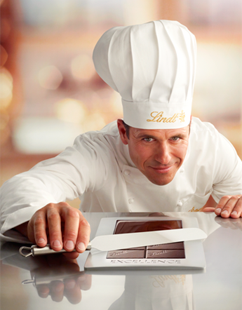
Lindt & Sprüngli, Master Chocolatiers since 1845.
In 1946 his grandson, John Haigh, proactively wrote letters to all the internationally accredited master chocolatiers, a strategy encouraged by business mentors and coaches to this day.
He received one reply from Swiss chocolate maker, Lindt & Sprüngli, with whom John trained . Returning via the United States, he sought out production processes, shop layouts and contemporary marketing ideas from packaging to promotional concepts.
Adelaide Historic Icons Unite
 The Art Deco Capri Cinema Built 1941 in Goodwood.
The Art Deco Capri Cinema Built 1941 in Goodwood.
To this day the Art Deco Capri Theatre on Goodwood Road maintains loyal ties with Haigh’s Chocolates. The rest is history, as they say. Haigh’s brand is a much loved South Australian Icon. Stratmann's legacy was almost lost but for the information that traveled through a century, attached by humble sticky tape, written by Rachel Biven in April 1990.
I salute you Rachel.
© Sandra J Ker, Antiquarian Print Gallery (1989-2018), Pasadena
FOOTNOTE: Rachel Biven was known to me as the author of a precious book, “Some Forgotten, Some Remembered : Women Artist’s of South Australia” (1976). Women artists were often nothing more than footnote to history, given their main values considered as wives and mothers. Also, I fondly remember a wonderful botanical artist, Pam Brindsley, whose meticulous botanical art I framed for two decades. On mentioning Rachel Biven, her face lit up with obvious fondness. Pam had migrated from Britain in the 1960s and Sydenham Gallery, founded by Rachel, was where her work had been exhibited many times.
Yes, Adelaide is a small Australian City, but it has attracted many talented souls since 1836.
Recent Posts
- » Lady Sarah Lennox, King George III & The Honourable George Napier
- » Schomburgk's Botanic Garden & Park Plan, 1874
- » "City of Adelaide" Clipper Ship - What is Old Is New Again
- » Napoleon, Hudibrastic Poetry, Doctor Syntax & the Power of Satire
- » Colonial Melbourne to Albury "Parlour Car" Photo Connects to Adelaide Past & Present
